It is known that art the beginning, inherent in man, evident not only in those hours and minutes when he embroiders or knits lace. Mistress and heaps of knits so that you will admire. And the beauty and use of any labor go hand in hand.
A beautiful sheaf, okay belted svakom, pleasant to take in hands. Such a sheaf will not collapse, will not collapse on the way to Riga, and his overweening moisture.
Worked hand-made reapers and all notice. There is no doubt that among INIC with a rich imagination, was born in the early years, a seemingly simple puzzle: small Athanasius grass belted. And of course, every villager who with an effort, and who immediately recognized the little Athanasius rye or wheat sheaf. The grass he was belted in the literal sense of the word mainly in sukhmani when straw swiatlo was so fragile that was broken at the first careless move. Under the grass meant marsh plants — cattails and reeds that are specially soaked in the case of heat. When it was not so hot and from time to time rains fell sheaves knitted plaits-svetlami of straw. So little Athanasia appeared straw belted with a girdle. Ukrainian peasants called the sheaf in is an Enigma, a completely different name: the small Dorofeya belted brief. But this is not important, and the fact that the sheaf to the other mystery is likened to man. No wonder, if among ENIC suddenly found a mistress, who jokingly made Dorkface or Athanasius hand and placed among the stubble. This moment could be considered the birthday of the first straw sculpture. Although in fairness, the birthday straw sculptures might be considered that, when man first learned to knit sheaves.
Have a clever and neat reapers sheaves to be not only okay, but the same, like twins. To drafaki and Athanasius was not thin and not too thick, and at the time, there was a special measure (a kind of Canon!). Taking a handful of land protruding stems — as many as can fit in the left hand, cut them at the root with a sickle held in the right hand. Such bunches of stems called the Russian peasants rocna, or hands. And since all of the hands of adult women and adolescents differ in magnitude, straw bundles-ruchenki was a little different. But despite this, the sheaves should be uniform all over the field. So one Reaper to get a sheaf of medium size, joined together seven ruchenkah, and the other eight. United together bundles tied with harness (slalom, perevalom, scrotum). The lower inboard portion of the sheaf was called the rump, or gazovim and the upper one with beard, or colecovision (figure 29 a).
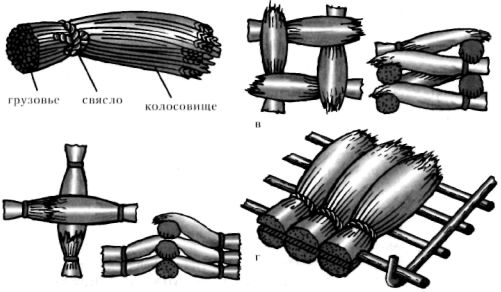
Figure 29
If there was no certainty in the weather imposed on the day the sheaves were placed in the sacrum and the beams. They had to be applied so that the straw and ears are sufficiently well ventilated, and in case of rain will not get wet. Here, neatly bound and beautifully laid sheaves and had the advantage before done carelessly and hastily.
The backs were made of two types. Some of them, viewed from above, was indeed similar to the crosses (figure 29 b). The sheaves in these backs fit so that in the place of their crossing, that is in the middle, gazovie a single sheaf lying on top of another Guzova. In case of rain, mainly suffered only the top sheaf. Other backs resembled the well log (figure 29). And the sheaves they fit so that the ears of each of them lay on the rump the next. Was closed quadrangle is the crown. Each sacrum composed of three or four crowns.
But still was the most perfect way of storing sheaves in Susannah. The word is derived from the ancient Suzlon to sucanat, that is to lean. The title accurately reflected the principle of drawing up of suslonov of sheaves. On the number of sheaves in Susannah, and they can be judged according to the ancient mysteries. One of them says: the four brothers the fifth is planted upside down. To put this Susan, four sheaves (the brother) put the butt down, ears up, leaned against each other. The fifth sheaf turn it over, flattened it Kolosova, or beard, to make a sort of dome, and covered them from above the serried peaks of four standing on the ground sheaves. The top sheaf was, in fact, a roof that didn't allow to soak under her ears.
In another puzzle the question is, what —nine brothers under one hat? Judging by the number of brothers, we are talking to her about aslone, in which nine bundles arranged in a circle, connected by vertices, and covered with a cap as the tenth sheaf. The upper sheaf, put your rump up, the peasants were sometimes called hood because he reminded them of the traditional headgear of Orthodox monks, which is a high conical hat with a veil. In twilight susleni recalled standing in a field lush of women in sundresses (figure 30 a). Perhaps, therefore, called them the people of attendants.
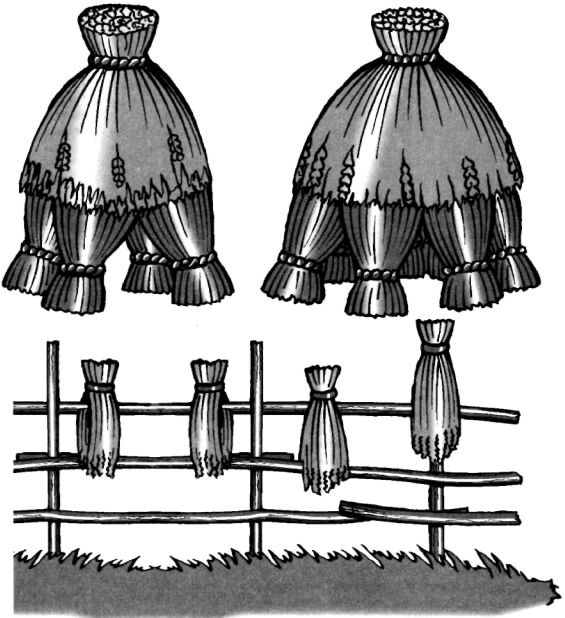
Figure 30
Simple and ingenious defense bundles from the rain in susanah not paid attention to the peasant builders in the construction of the skate on the crest of thatched roof (figure 29 g). In the North, where on the ground to put susany was impossible, the sheaves were placed on the poles of the fence, a specially adapted for these purposes (figure 30 b). In the evening on the background of the sunset sky they looked fantastic birds, priceusa to rest on the fence. The reception of mounting the sheaves on the pole in peasant folk architecture everywhere was used in shaping the eaves thatched roof. Bundles, laid with overlap, protected wslabi of the roof from strong winds and heavy rains. Needless to say that the techniques the binding of sheaves and the construction of them suslonov had a huge influence on the folk decorative-applied art — first and foremost on the artistic treatment of straw. The same techniques are used for the manufacture of the giant straw carnival figures and small dolls, which are made for the amusement of the kids.
Maslenitsa doll, the so-called Kostroma, who personified the past winter, with all its hardship, was usually the result of collective efforts. Each carried in a makeshift workshop under the open sky all I could: ripped clothes, threshed the sheaves, pieces of half-rotted burlap and other junk. During the joint work definitely stood out the most able sculptor, who supervised the entire work. The giant doll was supposed to be ridiculous and unsightly, so it was not a pity at the end of the holiday to bring it to the fire or put on a raft down the river.
A bundle of straw, wrapped up in a bundle, anciently served as the basis of the traditional peasant toys. In all likelihood, the first straw toys were born as if in the field at harvest time, when peasant women often had to take small children. Of course, when no one was looking, they were skittish. And maybe, somehow, to appease the child, peasant woman and made primitive doll from the first that fell into the hands of the straw-harness (swala) used to bind sheaves. Folded in half harness vaguely resembled the head, and radiating down below the fan of the straw — dress or sundress. Then figure doll became gradually more difficult. Maybe in the short moments of relaxation reapers child asked her to make doll hands. And found the simplest solution: insert a bundle of straw perpendicular to the torso, tying it in the middle and on the edges as well as tie with svakom sheaves.
In the future design of the straw doll to improve. There are items with more subtle finishes. In the manufacture of such dolls was needed for not only their ability to bind the sheaves, but also skillful techniques of weaving, the innate artistic taste and ingenuity. Gradually stood out talented seamstresses, who are not already in the field, and in a relaxed home environment began to make dolls, figures of horses, deer, and various fantastic animals (figure 31). In our days, the sculpture made of straw, created by the talented folk artists used to decorate the interior. With her in the house of citizen comes filled with sunlight, natural material, keeping the warmth of human hands.
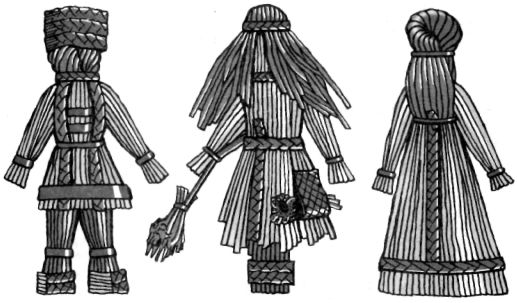 Figure 31
Figure 31A doll
For the manufacture of decorative sculptures and toys are used as whole stems of gramineous plants, and their upper legs with the long straw. Whole trunks go to large items, and the upper internode — medium and small.
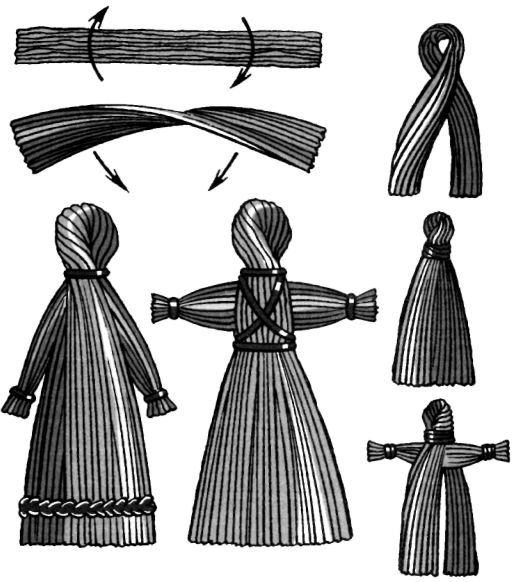 Figure 32
Figure 32Below the straw was flexible and, as well as for weaving, soaked in water and then wrap while you work in wet canvas. Ready straw figures trim pieteikumi.
At the heart of any modern toys or decorative sculpture made of straw are the simplest design decisions found in the distant past. Bundles of straw, tied in several places and connected to each other in a certain order, provide an opportunity to transfer in conventional and concise manner a human figure (figure 32), beast, birds and more. As in the past, the basis of the doll are two bunches of straw, joined at right angles to each other. However, modern dolls are still some of the design features.
Starting to make the torso, a bundle of straws as hard as you can tie a strong cord close to the end of the cut (figure 33 a). Then all the straw bent in the direction of the sling (figure 33 b), and tie another piece of string. The resulting rounded shape to serve as the basis of a head of the doll. Gathering other, more subtle, a bunch of straws and tie it with twine near the end slices. In a thin beam for strength insert the wire (figure 33). It should be soft, but at the same time to maintain good form. A bundle of straw intended for the body, divided into two equal parts and the interval between them is inserted a marshy beam reinforced with wire. Then both beams are bandaged crosswise, and thick bunch more and across in two places to mark the neck and waist of the figure. So strings were not visible, they wind on top of straw ribbons (figure 33g). After winding, the tip of the remaining tape to stick gently under the layers of windings.
The based doll is ready. From this moment everything depends on the desire and taste of the wizard. He may not actually dressing the doll but discretion in the peasant or urban clothing, wear any hat, to give the hands any position to invest in them the desired object — in short, everything will depend on the tasks posed in front of the master.
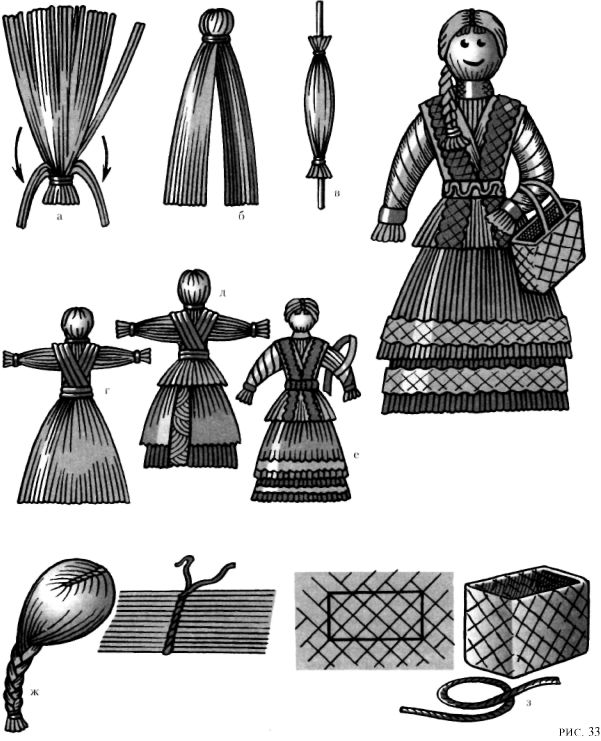
Depending on the size of the figures, you can use copper, aluminum and steel wires with a thickness of 1 to 2 mm. Through the wire master can bend the straw the beam as he pleases. Our image shows the production of female figures in urban clothing: her jacket, dress with apron, and in the hands of the shopping basket. On this basis, the figure can be called a "hostess".
To get the bottom line of the apron and the jacket on the figure put rubber rings, sliced, for example, old Bicycle inner tube. Focusing on the gum, carefully cut with scissors two or three layers of straws (figure 33 d). If you want to make the dress more magnificent, in the middle of the beam from the end face of the hammer a lump muddled straw. Then to the dress, jacket and skirt sewing threads braids-chetyrehrazovoe (Christmas trees) that mimic ruffles and patterns (figure 33 e). Hands wrapped straw with tape. While the straw has dried, they impart the desired position. To do the hairstyle with a scythe, placed in a number of hydrated straw, twist them rope and fixed on the doll and sticking the ends of the braid pigtail (figure 33 f). Of smooth straw strips to weave the basket. As a template using a wooden block of suitable size or a matchbox (figure 33 b).
Decorative wall panel "Owl"
The basis panel is flattened snopek straw. It is made from conventional sinopica, by driving the top wedge, cut from plywood (figure 34 a). Flattened the sheaf is combed with a special comb, putting the straw in neat rows. Comb cut from a piece of wood. On one of its faces, at a distance of 1 cm from each other, pierce the clove with the bitten off hats. To the tips of the nails don't scratch the straw, each one polished with a file, giving it a rounded shape. At one end of the bar cut out handle. In the next stage, the flattened snopek cut with scissors, as shown in figure 34 b. At the top of the straw is cut at the steep, and down a sloping curved line. Ledges sheared straw will simulate In the conventional manner of the plumage of a bird.
That straw has not stood up, and the has maintained a flattened shape, sprinkle it with warm water and comb again pressed against the top Board with the yoke.
Another major detail of the mural also represents snopek. Only it is much thinner and tied with string not at the end, and in the middle (figure 34). Both halves of snopika comb and spread like a fan. To maintain the shape of fans, twist straw rope. To the fans sew around the circumference of the toothed platezhki-chetyrehrazovoe (herringbone). Closing the circle, pletion continue to sew in a spiral, shifting its center closer to the sling of snopika (figure 34 g). In the middle of each spiral stitch buttons or sections of branches with expressive textured. It is desirable that at the end of the branches are well differed the dark core and the light sapwood. Such a texture could not be better mimics the bird's eyes. Such cuts usually occur in branches of fruit trees — plum, Apple, cherry etc. All of the panels connect together (figure 34 d). At the end of a suitable bitch cut a hooked nose owls, which is carefully sanded and rubbed with linseed oil.
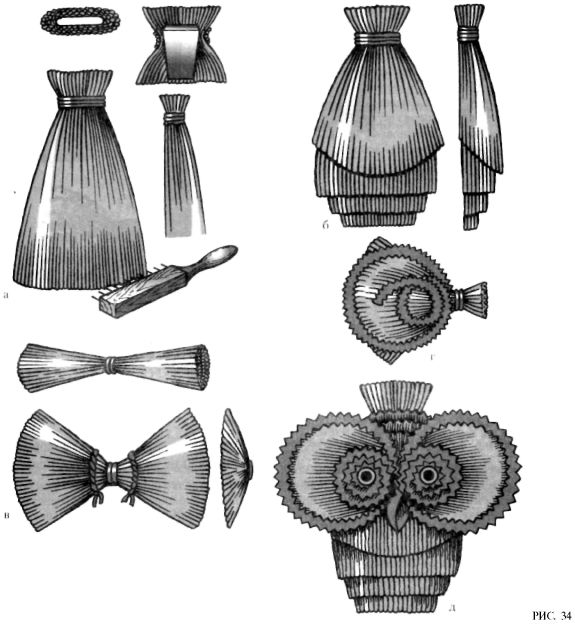
"The Golden-mane steed"
The ancient Slavs, the horse was revered as a symbol of the sun God, bestowing life and prosperity of all living things on earth. Therefore, the image of a horse had a magical significance, served as a protection of man and his home. Even in pre-Christian times were common decorations in the form of pendants with images of horse. The suspension served as amulets, protecting the man when he was far from home. The house slave with all his household, too, was guarded by the horse — the messenger of the sun. So, many centuries in Russia the carved image of a horse was decorated with overhanging gable end oklopna. Gradually the horse began to call is also okhlupen plank of wood with a groove that protects the ridge of the roof from the rain. This tradition has been so enduring in our time that such details of the roof from ceramic, slate and tin are still called skates. Toy with the image of the horse in abundance to meet the masters, working with a variety of materials, including straw...
The rapid running of a horse in the perception of the people associated with the movement of the sun and the flight of the wind. Maybe that is why in straw toys, depicting the galloping horse, craftsmen lush fan was dissolved mane, likening her to the sun rays.
Decorative figurine of a horse made of straw can decorate any modern interior, but at the same time and let me remind you about the ancient origins of folk art. Collect the figurine of the two Snopkov. One snopik as tight as you can twist near the end of the cut soft wire, leaving two long free ends (figure 35 a). Then all bend the straw through the wire ring in the opposite direction. The wire ends should be inside the bundle of straw (figure 35 b). The beam, which will be formed the head, neck and front legs, tightly tie the twine and the upper part of the bend arch (figure 35).

In doing so the basis of the head and neck, start making the mane (figure 35 g). This is the most expressive part of decorative figures are deliberately exaggerated proportions and shape of the mane. From the horse if it comes sunshine. This solution mane meets folk traditions, where the horse was revered as a symbol of the sun. The mane is collected from the individual Solomin, and sometimes of the smaller beams. Each culm alternately round the neck of the horse and twist the rope a specially prepared bundle of straw or hemp.
When the mane is ready, take a new bundle of straw and rounding it around the body, pulls tight with twine (figure 35 d). Retreating some distance, the beam pulls the string again, thus the torso of the horse. The remaining part of the straw harness is divided into three parts, of which will be made by the hind legs and tail. The two parts of the harness, which should be the ends of the wire temporarily bent at a right angle to the body and near the end slices, tie with twine. Third, the remaining part is used to make the tail. Finally finish the last stage. And while doing the front legs, splitting the first in half a bundle of straw so that the ends of the wire were in the middle of each half. To denote the knees, each of the four legs twisted in the middle with string, and then strips of straw. The ends of the wire sticking out of the straw, or cut with wire cutters, or bend and hide it so they were not visible from the outside. Then the legs bend so that the impression was a swift run of the horse.
At last, the final stage start finish figure. Without exception, all the places that were tied with string, wrapped with strips of straw. You want to hide all foreign materials, to create the impression that the figure is completely made of straw. From separate straws cut out the eyes and ears, and then attach them to the head using thread and needle. Made of straw strips platezhki-dvuhkonturniy, sew them to the body in the form of various decorative swirls. Finally, start the scrolling of the tail. The straw is lowered to one to two minutes in hot water and dissolve every stubble with the tip of a knife or scissors, into two or three parts. The thus obtained strips curl straw with straw curlers (figure 35) or a heated metal rod, mounted on a wooden handle. If you still have decided to make cold wave, it is necessary to make about two or three dozen straw curlers. They are short tubes made of thick basal internodes with one node. A tube slightly split a knife with one hand and insert the split one of the straw stripes of the tail. Winding the strip into a tube, stick in splitting the remaining tip of the strip. In the same way curl all the other strips, using the prepared eyelash curler. After a few hours when the straw dries, twist the strips carefully removed from curler. If after this the strips will be twisted too tight, curls dipped in cold water or sprayed from a spray. Moisture the curls will soon begin to unwind. So you need to act quickly and very carefully. Curls straighten fingers, slightly twisted, bent in one direction or another to the tail of a horse running as if fluttered from the flow of oncoming air, emphasizing the dynamics of the movement.



